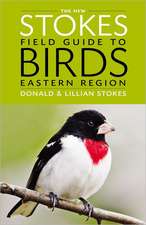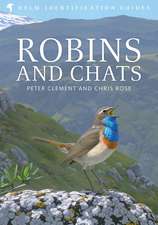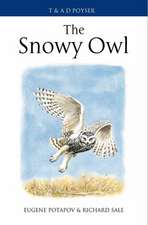Ecology and Conservation of North American Sea Ducks: Studies in Avian Biology
Editat de Jean-Pierre L. Savard, Dirk V. Derksen, Dan Esler, John M. Eadieen Limba Engleză Paperback – 19 feb 2018
Chapters are organized conceptually to focus on, compare, and contrast the ecological attributes of the tribe. Experts provide in-depth treatments of a range of topics, including:
- Population dynamics and genetics
- Infectious diseases and parasites
- Breeding costs and cross-seasonal affects
- Contaminant burdens
- Foraging behavior and energetics
- Migration strategies, molt ecology, and habitat affinities and dynamics
- Breeding systems and reproductive behavior
- Harvest history
Key Selling Features:
- Provides the first comprehensive assessment of the status, population dynamics, and demography of sea ducks across North America
- Characterizes phylogeography, phylogenetics, and population genetics
- Examines the diseases, parasites, biological toxins, and contaminants affecting sea ducks
- Provides an up-to-date assessment of migration and molt strategies
- Documents reproductive energetics, strategies, and behavior
| Toate formatele și edițiile | Preț | Express |
|---|---|---|
| Paperback (1) | 523.13 lei 6-8 săpt. | |
| CRC Press – 19 feb 2018 | 523.13 lei 6-8 săpt. | |
| Hardback (1) | 1356.88 lei 6-8 săpt. | |
| CRC Press – 13 apr 2015 | 1356.88 lei 6-8 săpt. |
Preț: 523.13 lei
Preț vechi: 615.45 lei
-15% Nou
Puncte Express: 785
Preț estimativ în valută:
100.12€ • 104.25$ • 84.61£
100.12€ • 104.25$ • 84.61£
Carte tipărită la comandă
Livrare economică 11-25 martie
Preluare comenzi: 021 569.72.76
Specificații
ISBN-13: 9781138575790
ISBN-10: 1138575798
Pagini: 612
Ilustrații: 4 Color Insert/16 Color Figures follows page 304; Approx 12 equations; 42 Tables, black and white; 16 Illustrations, color; 107 Illustrations, black and white
Dimensiuni: 178 x 254 x 31 mm
Greutate: 1.08 kg
Ediția:1
Editura: CRC Press
Colecția CRC Press
Seria Studies in Avian Biology
ISBN-10: 1138575798
Pagini: 612
Ilustrații: 4 Color Insert/16 Color Figures follows page 304; Approx 12 equations; 42 Tables, black and white; 16 Illustrations, color; 107 Illustrations, black and white
Dimensiuni: 178 x 254 x 31 mm
Greutate: 1.08 kg
Ediția:1
Editura: CRC Press
Colecția CRC Press
Seria Studies in Avian Biology
Cuprins
Status and Trends of North American Sea Ducks: Reinforcing the Need for Better Monitoring. Phylogenetics, Phylogeography, and Population Genetics of North American Sea Ducks (Tribe: Mergini). Population Dynamics of Sea Ducks: Using Models to Understand the Causes, Consequences, Evolution, and Management of Variation in Life History Characteristics. Infectious Diseases, Parasites, and Biological Toxins in Sea Ducks. Dealing with Deficits: Breeding Costs, Nutrient Reserves, and Cross-Seasonal Effects in Sea Ducks. Metals and Trace Elements, Petroleum, Organic Pollutants, and Radiation in Sea Ducks. Foraging Behavior, Ecology, and Energetics of Sea Ducks. Variation in Migration Strategies of North American Sea Ducks. Remigial Molt of Sea Ducks. Site Fidelity, Breeding Habitats, and the Reproductive Strategies of Sea Ducks. Breeding Systems, Spacing Behavior, and Reproductive Behavior of Sea Ducks. Harvest of Sea Ducks in North America: A Contemporary Summary. Habitats of North American Sea Ducks. Conservation of North American Sea Ducks. Conclusions, Synthesis, and Future Directions: Understanding Sources of Population Change. Appendix A: North American Sea Ducks. Index.
Notă biografică
Jean-Pierre L. Savard is a scientist emeritus with Environment Canada, Quebec, Canada. Dr. Savard earned his PhD from the University of British Columbia, where he conducted research on the territorial behavior, nesting success, and brood survival of Barrow’s Goldeneye, Common Goldeneye, and Bufflehead Ducks. He has published numerous papers focused on the biology and population dynamics of sea ducks including Common Eider, Harlequin Duck, Surf Scoter, Black Scoter, Long-Tailed Duck, Bufflehead, Barrow’s Goldeneye, Common Goldeneye, Hooded Merganser, and Red-Breasted Merganser.
Dirk V. Derksen is retired from the U.S. Geological Survey, Alaska Science Center, Anchorage, Alaska, where he served as chief of migratory bird, terrestrial mammal, and genetics research over a 26-year period. Dr. Derksen earned his PhD from Iowa State University and conducted his dissertation research on Adelie penguins in Antarctica. He studied habitat ecology of waterbirds on the North Slope of Alaska and published a suite of papers detailing the freshwater and marine wetland and terrestrial areas important for Spectacled Eiders, King Eiders, and Long-Tailed Ducks.
Daniel Esler is a research wildlife biologist with the U.S. Geological Survey, Alaska Science Center, Anchorage, Alaska, where he leads ecological studies of nearshore marine systems along the Pacific Coast of North America. Dr. Esler examined the effects of the 1989 Exxon Valdez oil spill on the demography of Harlequin Ducks during winter in Prince William Sound, Alaska, for his PhD at Oregon State University. He has published extensively on the biology of sea ducks including Steller’s Eider, Spectacled Eider, Harlequin Duck, Surf Scoter, White-Winged Scoter, Black Scoter, and Barrow’s Goldeneye.
John M. Eadie is Dennis G. Raveling Professor in Waterfowl Biology and chair of the Department of Wildlife, Fish & Conservation Biology, University of California, Davis, California. Dr. Eadie earned his PhD in zoology at the University of British Columbia, where he researched the reproductive ecology and behavior of Barrow’s and Common Goldeneyes. His numerous publications cover a diversity of behavioral and ecological aspects of sea duck species including Steller’s Eider, Harlequin Duck, Surf Scoter, Bufflehead, Barrow’s Goldeneye, and Common Goldeneye.
Dirk V. Derksen is retired from the U.S. Geological Survey, Alaska Science Center, Anchorage, Alaska, where he served as chief of migratory bird, terrestrial mammal, and genetics research over a 26-year period. Dr. Derksen earned his PhD from Iowa State University and conducted his dissertation research on Adelie penguins in Antarctica. He studied habitat ecology of waterbirds on the North Slope of Alaska and published a suite of papers detailing the freshwater and marine wetland and terrestrial areas important for Spectacled Eiders, King Eiders, and Long-Tailed Ducks.
Daniel Esler is a research wildlife biologist with the U.S. Geological Survey, Alaska Science Center, Anchorage, Alaska, where he leads ecological studies of nearshore marine systems along the Pacific Coast of North America. Dr. Esler examined the effects of the 1989 Exxon Valdez oil spill on the demography of Harlequin Ducks during winter in Prince William Sound, Alaska, for his PhD at Oregon State University. He has published extensively on the biology of sea ducks including Steller’s Eider, Spectacled Eider, Harlequin Duck, Surf Scoter, White-Winged Scoter, Black Scoter, and Barrow’s Goldeneye.
John M. Eadie is Dennis G. Raveling Professor in Waterfowl Biology and chair of the Department of Wildlife, Fish & Conservation Biology, University of California, Davis, California. Dr. Eadie earned his PhD in zoology at the University of British Columbia, where he researched the reproductive ecology and behavior of Barrow’s and Common Goldeneyes. His numerous publications cover a diversity of behavioral and ecological aspects of sea duck species including Steller’s Eider, Harlequin Duck, Surf Scoter, Bufflehead, Barrow’s Goldeneye, and Common Goldeneye.
Recenzii
"…extremely useful for researchers interested in sea ducks, other waterfowl, or avian ecology in general."
—J.L. Hunt, University of Arkansas, in CHOICE
"This a must-have book for scientists whose focus is waterfowl. However, every science library must also have it for others with more general interests ranging from environmental contaminants to population dynamics to diseases and parasites to reproductive strategies, breeding behavior, and more. Essentially everything that has been the subject of study within the Mergini is addressed thoroughly and carefully."
—Bruce D. Batt, in The Condor, May 2016
"...the editors along with the contributors of this book are to be congratulated for an outstanding accomplishment. The importance of this synthesis cannot be overstated as many sea duck populations in North America have been declining...This milestone work will contribute greatly to assist both waterfowl biologists and government decision-makers in what future research needs to be done and in the formulation of new policies to ensure the protection of coastal, offshore and inland habitats from further human developments and harmful activities. Ecology and Conservation of North American Sea Ducks should be on the desks of every waterfowl biologist and manager, and anyone with an interest in waterbirds and their habitats."
—David N. Nettleship, in VoicePipe 72, January 2017
—J.L. Hunt, University of Arkansas, in CHOICE
"This a must-have book for scientists whose focus is waterfowl. However, every science library must also have it for others with more general interests ranging from environmental contaminants to population dynamics to diseases and parasites to reproductive strategies, breeding behavior, and more. Essentially everything that has been the subject of study within the Mergini is addressed thoroughly and carefully."
—Bruce D. Batt, in The Condor, May 2016
"...the editors along with the contributors of this book are to be congratulated for an outstanding accomplishment. The importance of this synthesis cannot be overstated as many sea duck populations in North America have been declining...This milestone work will contribute greatly to assist both waterfowl biologists and government decision-makers in what future research needs to be done and in the formulation of new policies to ensure the protection of coastal, offshore and inland habitats from further human developments and harmful activities. Ecology and Conservation of North American Sea Ducks should be on the desks of every waterfowl biologist and manager, and anyone with an interest in waterbirds and their habitats."
—David N. Nettleship, in VoicePipe 72, January 2017
Descriere
Reflecting the considerable research recently conducted, this book examines the 15 extant species of sea ducks that populate North America. It provides a benchmark for where we are in conservation efforts and suggests future directions for researchers, managers, students, conservationists, and avian enthusiasts.



















